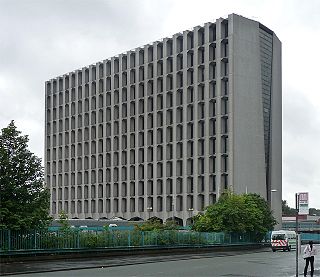
Imperial Chemical Industries (ICI) was a British chemical company. It was, for much of its history, the largest manufacturer in Britain. It was formed by the merger of four leading British chemical companies in 1926. Its headquarters were at Millbank in London. ICI was a constituent of the FT 30 and later the FTSE 100 indices.

Sir William Henry Perkin was a British chemist and entrepreneur best known for his serendipitous discovery of the first commercial synthetic organic dye, mauveine, made from aniline. Though he failed in trying to synthesise quinine for the treatment of malaria, he became successful in the field of dyes after his first discovery at the age of 18.

Coomassie brilliant blue is the name of two similar triphenylmethane dyes that were developed for use in the textile industry but are now commonly used for staining proteins in analytical biochemistry. Coomassie brilliant blue G-250 differs from Coomassie brilliant blue R-250 by the addition of two methyl groups. The name "Coomassie" is a registered trademark of Imperial Chemical Industries.

Blackley is an area of Manchester, England. Historically in Lancashire, it is approximately 5 miles (8.0 km) north of Manchester city centre, on the River Irk.

Heinrich Caro, was a German chemist.

Raphael Meldola FRS was a British chemist and entomologist. He was Professor of Organic Chemistry in the University of London, 1912–15.
The Society of Chemical Industry (SCI) is a learned society set up in 1881 "to further the application of chemistry and related sciences for the public benefit".
Charles Frederick Cross FRS was a British chemist.

Lucky Core Industries Limited, formerly known as ICI Pakistan, is a Pakistani conglomerate company headquartered in Karachi. It manufactures polyester, pharmaceutical, agrochemical, soda ash, and veterinary medicine.
Francis Leslie Rose was a British chemist.
British Dyestuffs Corporation Ltd (BDC) was a British company formed in 1919 from the merger of British Dyes Ltd with Levinstein Ltd. The British Government was the company's largest shareholder, and had two directors on the board.
John Donald Rose FRS was a British industrial chemist, who worked for Imperial Chemical Industries from 1935 to 1972. His posts at ICI included director of research and chairman of the paints division. He was also Master of the Worshipful Company of Salters.
Professor Bodo Linnhoff is a chemical engineer and academic who developed Pinch Analysis, a methodology for minimising energy usage in the process industries. A first trial at ICI improved design on a refinery expansion which saved £1 million per year in energy, and subsequent examination of plants believed to be optimised averaged a 30% energy saving.
The Clayton Aniline Company Ltd. was a British manufacturer of dyestuffs, founded in 1876 by Charles Dreyfus in Clayton, Manchester.
Francis Arthur Freeth was a British industrial chemist. He spent much of his career at Brunner Mond and its successor Imperial Chemical Industries, as chief chemist, research manager and in a recruiting capacity, with particular knowledge of phase rule chemistry, and developed many processes related to the manufacture of explosives. He made a critical contribution to the British World War I effort by devising new ways to manufacture ammonium nitrate, which was recognised with an honour, and a smaller contribution in World War II for the Special Operations Executive. Freeth created links between Brunner Mond and Dutch chemistry, particularly at the University of Leiden where he met Kammerlingh Onnes and was awarded a doctorate.
Alfred Spinks, was a British chemist and biologist.

Hexagon Tower is a specialist science and technology facility located in Blackley, Manchester, England.

Rudolf Hugo Nietzki was a German chemist who specialized in industrial dyes derived from coal tar. While a professor at the University of Basel in Switzerland he initiated the university's association with to the local chemical industry.
Dr Cecil John Turrell Cronshaw FRSE DSc was a British industrial chemist, Manager of the Manchester Ship Canal and Director of the chemical giant, ICI. He was involved in the evolution of modern industrial dyes.
Levinstein Ltd was an important Manchester based British dye-making company founded by Ivan Levinstein (1845-1916). In 1918 the firm became part of British Dyestuffs Corporation which in turn formed part of Imperial Chemical Industries in 1926. The firm had operations in Salford, Hulton House in Blackley, and during World War I a sequestered German-owned plant in Ellesmere Port. The firm made the successful Blackley blue or Coomassie brilliant blue, a Manchester Brown, a Manchester Yellow dye and during WWI chemicals for military purposes.









